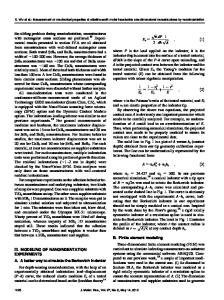The effects of alkaline earth metal ions and halogen ions on the chromium oxide activities in alkaline earth metal oxide
- PDF / 248,318 Bytes
- 7 Pages / 612 x 792 pts (letter) Page_size
- 89 Downloads / 378 Views
I. INTRODUCTION
ALKALINE earth metal oxide-halide-FeO system fluxes have been widely developed[1,2,3] in order to improve the extent of phosphorous removal from iron melts. With such fluxes, the dephosphorization ratio rises as a result of the beneficial influences of alkaline earth oxides and halides on the basicity, phosphate capacity, and fluidity of the slag phase and, thus, increases the reaction velocity of metals with fluxes. However, with regard to processing chromiumcontaining steels, e.g., stainless steels, ball bearing steels, etc., the important alloying element, chromium, is preferably oxidized by FeO in fluxes. The chromium retention ratio is thus lowered and the viscosity of the fluxes is enhanced. In order to preferably oxidize phosphorus rather than chromium from iron melts by means of appropriate oxygen-potential controls, alkaline earth metal oxide-halide-Cr2O3 system fluxes were applied.[4,5,6] The reactions of phosphorus and chromium between metal and fluxes can be represented as 6P(in iron) 1 5Cr2O3 (in fluxes) 5 10Cr(in iron) 1 3P2O5 (in fluxes)
[1]
In order to increase the ratios of phosphorus removal and chromium retention of iron melts, the P2O5 and Cr2O3 activities in the fluxes should be, respectively, as low and as high as possible. Cr2O3 activity in fluxes is affected by both temperature and flux composition.[6,7,8] If the Cr2O3 content in fluxes is low, its activity will also be low, and this will be disadvantageous for phosphorus removal and
LIAN-FU LI, Lecturer, and MAO-FA JIANG and WEN-ZHONG WANG, Professors, are with the Department of Ferrous Metallurgy, School of Materials and Metallurgy, Northeastern University, Shenyang 110006, China. ZHAO-PING CHEN, Senior Engineer, is with the Technology Center, Baosteel, Shanghai 201900, China. Manuscript submitted May 20, 1999. METALLURGICAL AND MATERIALS TRANSACTIONS B
chromium retention; on the other hand, if the Cr2O3 content is high and exceeds its solubility in the fluxes, the viscosity of the fluxes will be increased and the exchange between the fluxes and metal will be suppressed due to the kinetic limitation.[4] As the choice of alkaline earth metal ions and halide ions is considered as one of the most important influencing factors on the thermodynamic properties of the fluxes, it is of great importance to investigate the Cr2O3 activities and isothermal phase diagrams of the alkaline earth metal oxide-halide-Cr2O3 system fluxes. The solid electrolyte cell 2Mo.Cr 1 Cr2O3|ZrO2(MgO)|{Cu-Cr}alloy 1 (Cr2O3)fluxes.Mo1
[2]
is used in the present study to determine Cr2O3 activities in MO-MX2-Cr2O3 (M 5 Ca21 or Ba21; X 5 F2 or Cl2) fluxes and to discuss the effects of alkaline earth metal ions and halide ions on the thermodynamic properties of such system fluxes. II. EXPERIMENTAL As in the authors’ previous study,[6] the experimental setup was subdivided into four systems: gas purification, temperature determination and control, experimental furnace work, and data acquisition. Argon, which was used as protective gas of the system, was
Data Loading...










